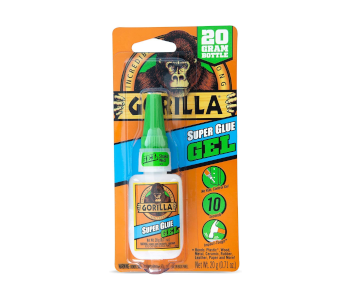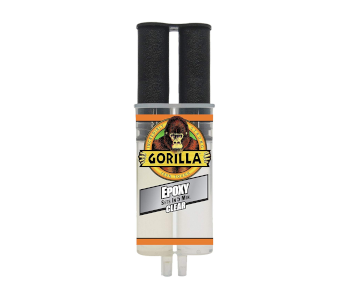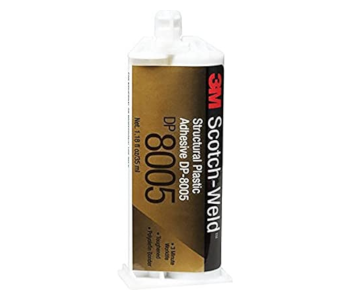what to use too adhere plastic to metal
3D Insider is ad supported and earns coin from clicks, commissions from sales, and other ways.
On their own, both metal and plastic are excellent and versatile materials. They are both fairly durable and hands accessible. While plastic is the cheaper and more than conditions-resistant option, metallic is a lot stronger and has a characteristic luster that enhances visual appeal. Combining the ii may seem like a good idea. In practice, this combination isn't quite as simple as it sounds.
Bonding metal to plastic is complicated considering they involve ii materials that are both difficult to glue. This isn't an insurmountable problem, though. If you lot're having trouble getting wood to stick to metallic (or vice-versa), then here are some useful tips.
Gear up the surface
A perfectly shine surface is the bane of any adhesive. Unlike wood, paper, or material, the surface of metal or plastic is not-porous. Thus, there is no way for the glue to be absorbed into the fabric to form a potent bond. The next best thing y'all can do is increase the surface area to which the glue tin can adhere to. This can exist done simply past sanding the surface of both the plastic and metal to which the glue volition exist applied to.
Technically, the term for this process is "scuffing." By scuffing a smooth surface, the penetration of any liquid compound can be greatly enhanced. In plastics, standard depression-grit sandpaper is adept plenty to create a crude surface. For hard metals, some steel wool may exist the most constructive tool. Take annotation that it doesn't take much to create a suitably crude surface – but a few seconds of treatment past either sandpaper or steel wool will do.
Make up one's mind how potent y'all demand the bail to be
Before we move on to the step where we option a glue for your project, you need to make up one's mind just how strong you need the connection between the metal and plastic parts to be. This can depend on what the projection is intended for.
A lot of people ask this question posed by this article's championship related to building models and action figures. In this instance, the forcefulness is non as important every bit how good the bonded parts await when the adhesive dries. These models also aren't likely to be moved around much or be subjected to extremes in pressure and temperature.
On the far finish of the spectrum are metal and plastic parts meant to exist bonded for commercial or industrial use. A few worthwhile examples are urethane seals in steel pipes and polypropylene panels in aluminum vehicle parts. In these types of applications, you will need to consider how the motility of the parts relative to each other tin can introduce stress to the layer of agglutinative. You will too need to consider the difference in elasticities of each material and how plastic and metallic react differently when exposed to temperature changes.
Cull a suitable agglutinative
In one case you lot have established the objectives for your project, it becomes much easier to cull an appropriate adhesive. In that location are basically two options to choose from: a cyanoacrylate-based super mucilage, and an epoxy-based gum. Each arroyo has pros and cons, which we shall hash out in detail.
Cyanoacrylate mucilage

Cyanoacrylate gum, more commonly known equally super glue, is the easiest selection when dealing with metal and plastics. Different "plastic glue", cyanoacrylate mucilage does not cook the plastic of the surface but just creates a strong layer of hardened adhesive one time it dries.
The biggest advantage of super glue is that it'southward very easy to apply. Well-nigh super glue products (such as Gorilla Super Glue Gel and Loctite Super Mucilage) come in modest plastic bottles with piece of cake-to-utilise applicators. This makes it like shooting fish in a barrel to use the glue exactly where you want to and minimizes waste.
Super glue is a relatively less viscid agglutinative with proficient penetrating power. To leverage this advantage, it's absolutely essential that yous scuff the surface of the plastic and metal parts. It too cures fairly rapidly and tin fifty-fifty be accelerated by moisture. What this means is that bravado on glue to help it dry out faster actually works.
On the downside, super glue tends to go everywhere when you utilise it. If you're working with very small and frail parts, information technology may exist tough to keep super glue from coming into contact with parts that aren't meant to be glued on. The results can range from hilarious to frustrating.
In terms of bond strength, super glue leaves a lot to be desired. This makes super glue more than suitable for activeness figures and models – objects that are meant to be looked at but non touched. The cracking thing about super glue is that information technology's very clear when information technology dries up, so it won't reduce the aesthetic entreatment of your projects.
Epoxy-based gum

For more challenging projects, we recommend a 2-role epoxy adhesive. Yous tin either get an epoxy adhesive with components that come in separate tubes or an epoxy putty. We recommend tube-based epoxy because they are much easier to apply and reduce the need to handle the adhesive with your hands. Splendid products include the Gorilla ii-Office Epoxy and the J-B Weld ClearWeld Epoxy.
The great thing about epoxy is that it can stick to only nigh annihilation (although this does not discount the need to scuff the surfaces of your parts). They also create bonds that are much stronger than super glue could always produce. If y'all're working on parts mean for functional use, so two-function epoxy is undoubtedly the more reliable option.
Epoxy is a viscous adhesive with poor penetration power. This poses a few issues in terms of handling and application of the adhesive. Scuffing the surface of the metal and plastic parts is fifty-fifty more crucial when using epoxy as it creates more surface area for the epoxy adhesive to latch onto.
During curing, you will also need to clamp the parts together to forcefulness the adhesive to get into those tiny spaces on the surfaces of the parts. You'll have to plan ahead for this requirement, as the curing process for epoxy can take several hours to exist completed. Have note that some adhesive can squirt out when the parts are clamped – wipe these away to ensure that your finished parts wait make clean.
Be wary of plastics with low surface energy

Plastics may be an incredibly mutual group of materials, but they tin can be deceptively difficult to work with as far as adhesion is concerned. This is because some plastics showroom low surface energy (LSE). What this means is that adhesives accept a hard time "wetting" the surface of such plastics, preventing them from forming a reliable bail.
The list of LSE plastics includes some of the most common plastics used in everyday life – polypropylene (PP), polyethylene (PE), polystyrene (PS), Teflon (PTFE) and polyvinyl alcohol (PVA). LSE plastics are typically cheaper, softer, easier to manufacture, and have lower densities than high surface energy (HSE) plastics
If you lot need to work with any of these plastics, and so the choice of the proper adhesive is a highly disquisitional stride. Fortunately, adhesive manufacturers recognize this challenge and offer products that accept been formulated to piece of work with LSE plastics. Notable examples include the 3M Scotch-Weld Instant Agglutinative and the 3M Scotch-Weld Structural Plastic Agglutinative.
Even with the right tools, working with LSE plastics can be a huge headache. Another pick you should consider is pivoting to HSE plastics instead. Mutual examples of HSE plastics include polyester, nylon, acrylic, PVC, and ABS. Any of the adhesives nosotros have mentioned in this commodity should piece of work perfectly fine with ABS.
Examination a glue if you're unsure (just ask outset!)
If you lot're unsure about how suitable your glue is for bonding metal to plastic, the beginning step y'all should take is to enquire the manufacturer for their recommendations. If yous bought your glue from a crafts store, they may fifty-fifty have recommendations on how you should utilize your glue or if other glues are more suitable.
If your uncertainly lies on the effectivity of such recommendations, then the best selection is to take matters into your own hands and do a test run. Before you lot work on your actual project, try applying the glue to small pieces of scrap metal and plastic that yous have lying around. Take note of how long the glue takes to completely harden, how strong the bond is, and if it has whatsoever elasticity. If the office you're working on is meant to exist exposed to the outdoor elements of extreme temperatures and humidity, and so you tin attempt and simulate those conditions.
Concluding thoughts
DIY projects are usually fun, but they tin chop-chop become frustrating when y'all're faced with a situation you take underestimated. Gluing metal to plastic is one such scenario. Later on all, how difficult can it be? Equally it turns out, gluing metal to plastic is a little more circuitous than one would expect.
The adept news is that this is a problem that mayhap thousands of people have faced before. You don't need to reinvent the cycle on this ane – merely become an adhesive that has already been proven to work. Past preparing the surface of your parts and selecting the proper adhesive, yous should take no problems getting your plastic and metal parts to stick together.
Source: https://3dinsider.com/how-to-glue-metal-to-plastic/
0 Response to "what to use too adhere plastic to metal"
Post a Comment